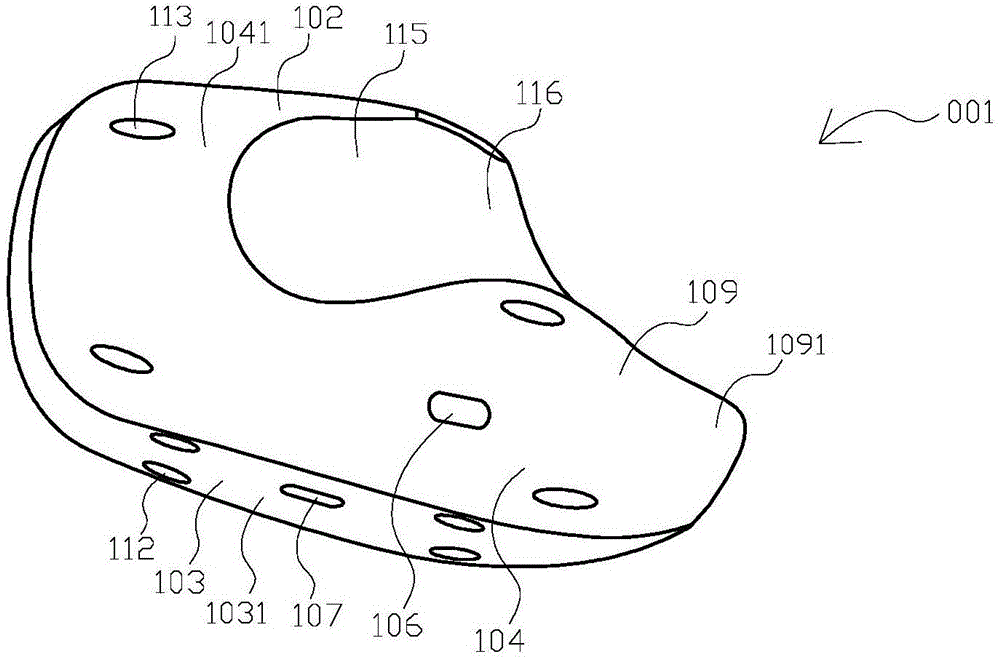Mouse
A mouse and housing technology, applied in the field of mouse, can solve problems such as pause, inconvenient operation posture change, erratic cursor, etc.
- Summary
- Abstract
- Description
- Claims
- Application Information
AI Technical Summary
Problems solved by technology
Method used
Image
Examples
Embodiment 1
[0043] Example 1: Please also refer to Figure 1A to Figure 1D ,as well as Figure 1E, the mouse 001 according to Embodiment 1 of the present invention includes a casing 102, and includes an image sensing element and a lens not shown in the figure. The housing includes a bottom 104 , a front end 108 , a rear end 109 , a rear end 1091 , an inner side 105 and an outer side 103 . The outer side has an outer side wall 1031 . A left key and a right key as main keys are arranged on the upper part of the front end of the housing, and a scroll wheel is arranged between the left key and the right key. The mouse 001 also includes: a first light source is provided to provide a first light beam. When the mouse is placed on the working surface 6 with the housing bottom 104 and slides to sense the moving state of the cursor, the first light beam passes through the housing A light-transmitting area 106 of the body bottom 104 is projected onto the working surface 6 ; and a first lens is co...
Embodiment 2
[0060] Please refer to Figure 5 The main difference between the mouse 005 of the second embodiment of the present invention and the mouse 001 of the first embodiment is that the mouse 005 is set on the inner side of the second half of the casing, and is used to slide the mouse 005 on the working surface outside the casing. The notch 053 for placing the thenar muscle part where the palm protrudes downward in the state of sensing the movement of the cursor includes a shell inner section 054 that is linearly inclined to the outside of the shell. The rear end 055 of the housing of the mouse 005 is on the outer side of the housing of the longitudinal section 057 that passes through the thickness center line of the roller 056 and is perpendicular to the axial direction of the roller. Compared with the notch 110 of the mouse 001 , which includes a casing inner section 111 that is recessed to the outside of the casing in a concave arc shape, the mouse 005 has a different notch shape ...
Embodiment 3
[0065] Please refer to Figure 6A , Figure 6B The main difference between the mouse 006 in the third embodiment of the present invention and the mouse 001 in the first embodiment is that the mouse 006 is set on the inner side of the second half of the housing, and is used to slide the mouse 006 on the working surface with the outer side of the housing 062. Move the notch 063 to place the thenar muscle that protrudes downward in the palm in the state of sensing the movement of the cursor, including a section from the rear end of the housing to the end of the rear end of the housing, from the inner side of the housing 061 to the outer side of the housing and toward the outer shell. The inner section 064 of the rear end of the concave arc-shaped housing is concave on the outside of the body, and the curvature of each point is equal or nearly equal, so that the rear end 065 of the housing is offset from the center line of the thickness of the roller 066 and the vertical section 0...
PUM
 Login to View More
Login to View More Abstract
Description
Claims
Application Information
 Login to View More
Login to View More - R&D
- Intellectual Property
- Life Sciences
- Materials
- Tech Scout
- Unparalleled Data Quality
- Higher Quality Content
- 60% Fewer Hallucinations
Browse by: Latest US Patents, China's latest patents, Technical Efficacy Thesaurus, Application Domain, Technology Topic, Popular Technical Reports.
© 2025 PatSnap. All rights reserved.Legal|Privacy policy|Modern Slavery Act Transparency Statement|Sitemap|About US| Contact US: help@patsnap.com



